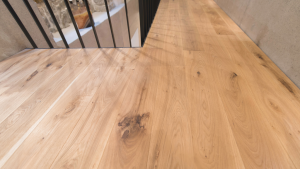When it comes to choosing hardwood flooring, homeowners are often torn between solid hardwood and engineered hardwood. Both are stylish, durable, and available in a wide range of colors and finishes. However, they differ in construction, performance, and cost, which can impact your decision depending on your lifestyle, budget, and long-term plans.
At Flooring.org, we offer a wide selection of both solid and engineered hardwood flooring options. This guide will help you understand the key differences and determine which is the best flooring choice for your home.

What Is Solid Hardwood Flooring?
Solid hardwood is made from a single piece of natural wood. Each plank is typically three-quarters of an inch thick and can be sanded and refinished multiple times.
Benefits of Solid Hardwood:
-
Long lifespan: Can last 50 to 100 years with proper care
-
High resale value: Great selling point for potential homebuyers
-
Timeless appeal: Natural variation and grain patterns
-
Can be refinished: Ideal for long-term homeowners
Ideal Applications:
Solid hardwood performs best in above-grade, climate-controlled areas such as living rooms, bedrooms, and dining rooms. Avoid using it in basements or areas prone to moisture.
What Is Engineered Hardwood Flooring?
Engineered hardwood is constructed with a real wood top layer (called the veneer) bonded to several layers of plywood or high-density fiberboard (HDF). This layered design gives engineered hardwood enhanced stability and moisture resistance.
Benefits of Engineered Hardwood:
-
Moisture resistant: Less prone to warping or shrinking
-
Versatile installation: Can be installed over concrete or radiant heat
-
More affordable: Often lower in cost than solid hardwood
-
Sustainable: Uses less slow-growth hardwood per plank
Ideal Applications:
Engineered hardwood is perfect for basements, kitchens, and bathrooms, as well as any room where humidity or temperature changes are a concern.
Comparing Solid vs. Engineered Hardwood
| Feature |
Solid Hardwood |
Engineered Hardwood |
| Construction |
One solid piece of wood |
Real wood veneer over plywood core |
| Moisture Resistance |
Low |
Moderate to high |
| Durability |
Very high, can be refinished often |
Moderate, limited refinishing |
| Installation Options |
Nail-down only |
Nail, staple, glue, or float |
| Cost |
Higher |
Lower to mid-range |
| Resale Value |
Excellent |
Very good |
Popular Choices at Flooring.org
Looking for tried-and-true styles? Here are some customer favorites:
-
Solid Oak Hardwood: Classic grain, available in natural, espresso, and golden tones
-
Engineered Hickory Flooring: Bold texture, great for rustic or farmhouse interiors
-
Engineered White Oak: On-trend neutral tones, perfect for modern and transitional spaces
Both solid and engineered options are available in a variety of plank widths, finishes, and stain colors to match your vision.
Which Is Right for You?
If you plan to stay in your home for many years and want flooring that can be refreshed over time, solid hardwood may be your best investment. On the other hand, if you need a more flexible, budget-friendly option that works in any part of your home, engineered hardwood is a smart and stylish choice.
Still not sure? Our team at Flooring.org can help you compare options and choose the best flooring based on your needs.
Browse Our Hardwood Collection
Whether you choose solid or engineered, you can trust Flooring.org to deliver quality products, competitive volume pricing, and fast shipping. Visit our online store today to explore:
-
Real hardwood flooring in oak, maple, hickory, and more
-
Engineered hardwood options designed for everyday durability
-
Underlayment and trim accessories for a seamless installation
The post Solid vs. Engineered Hardwood Flooring: Which Is Right for Your Home? appeared first on Flooring.org.
This post appeared first on http://www.flooring.org